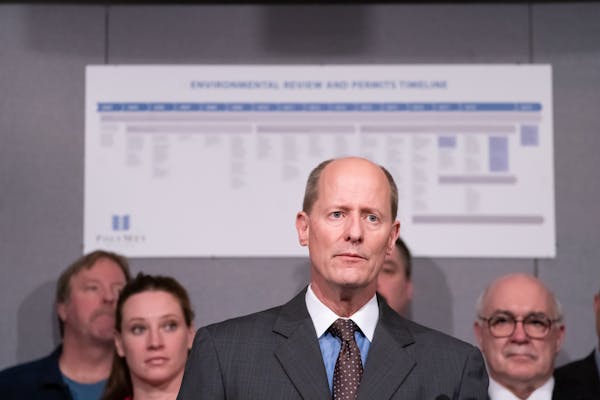The state's budget outlook crumbled from a $1.5 billion surplus to a projected $2.4 billion deficit in just two months, as the COVID-19 pandemic eats up tax revenue and Minnesota leaders accelerate spending to respond.
Tuesday's budget projection is the first estimate of just how deep a financial hole Minnesota could face. Budget officials predicted state revenue would be $3.6 billion less than anticipated and spending would be $391 million higher, including additional money the Legislature approved since February.
"The shock to the U.S. economy from the pandemic is unprecedented in modern postwar history, and the economic outlook is exceptionally uncertain and volatile," said state economist Laura Kalambokidis.
Budget officials typically give projections only in February and November, but the fast-spreading coronavirus prompted an unusual update. The latest numbers will guide lawmakers' decisions in the final couple of weeks of this legislative session, which is scheduled to end May 18 — and during a special session that Gov. Tim Walz said likely will follow.
The projection also allows Minnesota to draw money from the state's budget reserves.
It follows a string of strong budget forecasts and one of the longest periods of continuous economic growth in the nation's history. During the Great Recession, Minnesota experienced worse deficit projections. When former Gov. Mark Dayton took office in 2011, he had to contend with a looming $6.2 billion deficit.
Since then, Minnesota has built its budget reserves, amassing nearly $2.4 billion in a rainy-day fund and an additional $350 million in a cash flow account that can be used to offset revenue shortages.
"Today is a rainy day, unfortunately," Management and Budget Commissioner Myron Frans said Tuesday. He cautioned against relying solely on the reserves to close the gap, given the likelihood of continued declines in revenue and uncertainty about the economic toll of the coronavirus.
The numbers presented Tuesday are based on predictions from Minnesota's economic consultant, IHS Markit — which in February forecast 2.1% GDP growth for 2020. The consultant is now predicting a 5.4% decline this year.
The spread of COVID-19 is expected to peak and dissipate in the second quarter of this year, and restrictions like the stay-at-home order will be lifted in the third quarter, IHS predicted. The company expects economic growth late this year and expects the U.S. economy to return to full employment in 2024.
But the Minnesota Council of Economic Advisers, which includes academics, industry experts and a former state economist, warned that could be overly optimistic.
If there's a resurgence of the virus later this year — as the nation's leading infectious disease expert Anthony Fauci predicted — that could slow the recovery, the advisers warned. They also said social distancing could lead to small business closures and hurt employment growth, and the stock market's rebound could be more sluggish than IHS projected.
While it's impossible to predict exactly how the coronavirus will play out and what the ultimate financial toll will be, the Walz administration and legislators offered options to respond to the economic picture presented Tuesday.
"In a time of deep crisis, deficit spending at the federal level is absolutely necessary," Walz said, and he talked with Minnesota's congressional delegation Tuesday morning about the need for more federal aid for state and local governments.
Minnesota, unlike the federal government, must balance its budget.
State leaders could make up the potential shortfall by using reserves, cutting spending, increasing taxes or securing additional federal funding. Minnesota already received about $2 billion from the federal government during the pandemic, but that money is limited to COVID-19-related expenses. It cannot be used to plug a budget hole.
It quickly became clear the deficit projection would provoke new battles at the Capitol, where Republicans have been facing off with Walz and DFL legislators over which businesses should be allowed to reopen during the pandemic.
Senate Majority Leader Paul Gazelka said the state should respond to the deficit by renegotiating state employee contracts, rejecting increased spending that won't be reimbursed by the federal government, bonding carefully and reopening businesses.
"Most importantly, we need to open the economy to revenues that fund essential government services," Gazelka, R-East Gull Lake, said in a statement.
House Minority Leader Kurt Daudt, R-Crown, called on Walz to make budget cuts like the governors of Wisconsin and New York have done. They reduced spending by $70 million and $10 billion, respectively.
"Families and businesses cannot bear the burden of this crisis alone: government must share in the sacrifice," he said in a statement.
Walz said he plans to "put every scenario on the table" to fill the budget gap, including potential layoffs and furloughs of state workers. But Walz added that workers account for only about 7% of the state's budget. He has already instituted a hiring freeze on executive branch jobs.
DFL House Speaker Melissa Hortman, meanwhile, said she is relieved the projected deficit isn't larger. Hortman, DFL-Brooklyn Park, said in a statement that federal aid and reserves allow the state to do some additional spending.
"Investments are needed to make Minnesotans secure in their housing, help small businesses, facilitate distance learning and telemedicine," she said. "And to ensure we have the workforce we need to provide care for the elderly and people with disabilities."
Carolyn Parnell, 'trailblazer' who served as Minnesota's first IT commissioner, dies

